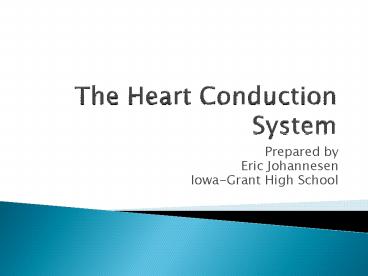The Heart Conduction System - PowerPoint PPT Presentation
1 / 13
Title:
The Heart Conduction System
Description:
... found in the right atrium. The electrical signal allows the pulse to spread across the atria. ... The atria contracts and forces blood into the two ventricles. ... – PowerPoint PPT presentation
Number of Views:1951
Avg rating:3.0/5.0
Title: The Heart Conduction System
1
The Heart Conduction System
- Prepared by
- Eric Johannesen
- Iowa-Grant High School
2
The Heart Conduction System
- The rate at which the heart beats is controlled
by the nervous system. - The actual beat begins within the heart itself
and will begin without any nerve supply - The cells that begin the heartbeat are called
pacemaker cells. - The pacemaker system is important in maintaining
the hearts regular rhythm. - The system must also function to make the heart
contract in a high organized manner. - The atria must contract so that blood is
efficiently pumped out of the heart.
3
The Pacemaker System
- Called the sinoatrial node (SA)
- Special group of muscle cells found in the right
atrium - The electrical signal allows the pulse to spread
across the atria. The atria contracts and forces
blood into the two ventricles.
4
Cardiac Cycle
- The Cardiac Cycle included one complete
contraction and a following relaxation phase - During relaxation, the atria fill with blood in
preparation for the next contraction. - Contraction phase is called Systole and the
relaxation phase is called Diastole - Blood pressure measurements are taken during both
phases of the cardiac cycle - The higher of the two numbers represents the
systolic phase (Contraction of the heart) and the
diastolic occurs when the heart relaxes. - In humans, a typical number is 120/75
5
Electrocardiogram
- The flow of ions that allows the cardiac muscle
to contract causes a small electrical current. - An ECG (Electrocardiogram) is the electronic
instrument that measures this small activity.
6
Sinus Rhythm-Normal Rate
7
Sinus TachycardiaHeart Rate Faster Than Normal
8
Sinus BradycardiaHeart Rate is Slower Than Normal
9
Atrial FibrillationThe SA node no longer acts as
the pacemaker.
10
Ventricular FibrillationThe ventricles fire
uncontrollably. Very serious condition. The
heart muscle quivers. Shockable rhythm.
11
AsystoleFlat Line Non-Shockable Rhythm
12
Lub-Dub
- The sound of Lub-Dub
- Lub is created when the ventricles contract
- Dub occurs when the ventricles relax
13
What effects heart rates?
- Elevated stress
- Illness
- Activity
- Cardiac Event
- Heart Murmurs
- Defective Valve or valves





























